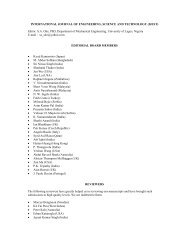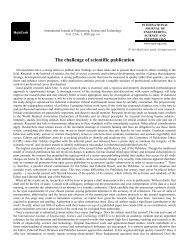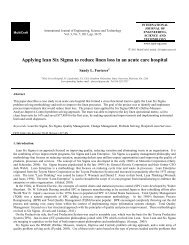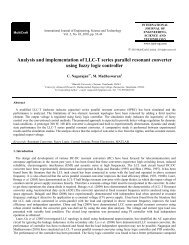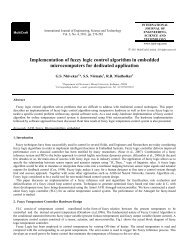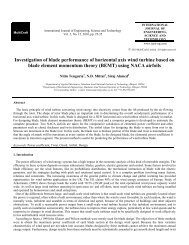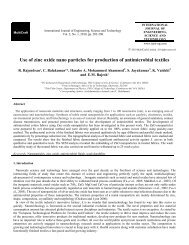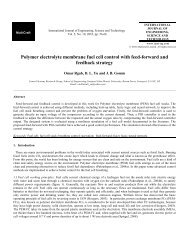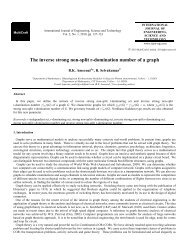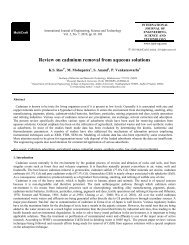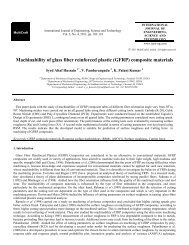Flow field development in a direct injection diesel engine with ...
Flow field development in a direct injection diesel engine with ...
Flow field development in a direct injection diesel engine with ...
Create successful ePaper yourself
Turn your PDF publications into a flip-book with our unique Google optimized e-Paper software.
MultiCraft<br />
International Journal of Eng<strong>in</strong>eer<strong>in</strong>g, Science and Technology<br />
Vol. 2, No. 1, 2010, pp. 80-91<br />
INTERNATIONAL<br />
JOURNAL OF<br />
ENGINEERING,<br />
SCIENCE AND<br />
TECHNOLOGY<br />
www.ijest-ng.com<br />
© 2010 MultiCraft Limited. All rights reserved<br />
<strong>Flow</strong> <strong>field</strong> <strong>development</strong> <strong>in</strong> a <strong>direct</strong> <strong>in</strong>jection <strong>diesel</strong> eng<strong>in</strong>e <strong>with</strong> different<br />
manifolds<br />
Benny Paul 1 *, V. Ganesan 2<br />
1,2<br />
Internal Combustion Eng<strong>in</strong>es Laboratory, Department of Mechanical Eng<strong>in</strong>eer<strong>in</strong>g, Indian Institute of Technology Madras, Chennai 600 036, India<br />
* Correspond<strong>in</strong>g author: e-mail:benny.mace@gmail.com<br />
Abstract<br />
This paper reports a study on the effect of helical, spiral, and helical-spiral comb<strong>in</strong>ation manifold configuration on air motion<br />
and turbulence <strong>in</strong>side the cyl<strong>in</strong>der of a Direct Injection (DI) <strong>diesel</strong> eng<strong>in</strong>e motored at 3000 rpm. Three-dimensional model of the<br />
manifolds and the cyl<strong>in</strong>der is created and meshed us<strong>in</strong>g the pre-processor GAMBIT. The flow characteristics of these eng<strong>in</strong>e<br />
manifolds are exam<strong>in</strong>ed under transient conditions us<strong>in</strong>g Computational Fluid Dynamics (CFD) code STAR-CD. The predicted<br />
CFD results of mean swirl velocity of the eng<strong>in</strong>e at different locations <strong>in</strong>side the combustion chamber at the end of compression<br />
stroke are compared <strong>with</strong> experimental results available <strong>in</strong> the literature. We also compared the volumetric efficiency of the<br />
modeled helical manifold. The results obta<strong>in</strong>ed showed reasonably good agreement <strong>with</strong> the measured data given <strong>in</strong> the<br />
literature. Further, this paper discusses the predicted flow structure, swirl velocity and variation of turbulent energy <strong>in</strong>side the<br />
cyl<strong>in</strong>der <strong>with</strong> different manifold. Comparisons of volumetric efficiency <strong>with</strong> different manifold configuration at 3000 rpm speed<br />
are also presented. The turbulence is modeled us<strong>in</strong>g RNG k-ε model. It is observed that helical-spiral manifold gives the<br />
maximum swirl ratio <strong>in</strong>side the cyl<strong>in</strong>der than helical manifold. But volumetric efficiency observed is less for helical-spiral<br />
manifold eng<strong>in</strong>e. Swirl <strong>in</strong>side the eng<strong>in</strong>e is important for <strong>diesel</strong> eng<strong>in</strong>e. Hence, for better performance a helical-spiral <strong>in</strong>let<br />
manifold configuration is recommended.<br />
Keywords: <strong>Flow</strong> structure, spiral manifold, helical manifold, helical-spiral comb<strong>in</strong>ed manifold, turbulence, swirl, CFD, Diesel<br />
eng<strong>in</strong>e<br />
1. Introduction<br />
<strong>Flow</strong> of air through the manifold and mix<strong>in</strong>g of the fuel <strong>with</strong> air <strong>in</strong>side the cyl<strong>in</strong>der is more important <strong>in</strong> the case of <strong>diesel</strong> eng<strong>in</strong>e<br />
because these factors, <strong>direct</strong>ly affect the volumetric efficiency, combustion performance, output and emission levels of the eng<strong>in</strong>e.<br />
Control of flow through the manifold is critical for meet<strong>in</strong>g the emission regulations and fuel economy requirements. Parameters<br />
like eng<strong>in</strong>e speed, manifold and combustion chamber configuration (Chen et al., 1998) <strong>direct</strong>ly <strong>in</strong>fluence the swirl <strong>in</strong> DI <strong>diesel</strong><br />
eng<strong>in</strong>es and subsequently it plays a vital role <strong>in</strong> mix<strong>in</strong>g air and fuel <strong>in</strong>side the cyl<strong>in</strong>der. Optimization of swirl becomes an<br />
important aspect <strong>in</strong> the design of <strong>in</strong>take systems of <strong>diesel</strong> eng<strong>in</strong>es.<br />
Nowadays, <strong>with</strong> the availability of powerful computers, the CFD prediction methods for <strong>in</strong>-cyl<strong>in</strong>der flow of IC eng<strong>in</strong>es have<br />
become popular. They can give very useful <strong>in</strong>formation regard<strong>in</strong>g the flow pattern and has the potential to reduce the total<br />
<strong>development</strong> time of the <strong>in</strong>take system of an IC eng<strong>in</strong>e. Eng<strong>in</strong>e manufactures require precise eng<strong>in</strong>e design to br<strong>in</strong>g the end<br />
product to the market <strong>in</strong> a short time period and hence CFD codes play an important role <strong>in</strong> IC eng<strong>in</strong>e design.<br />
Borgnakke (1981) presented a flow model to predict the swirl vortices and turbulence <strong>in</strong> an open chamber cup-<strong>in</strong>-piston eng<strong>in</strong>e.<br />
The work was compared <strong>with</strong> experimental data over a range of eng<strong>in</strong>e <strong>in</strong>take manifold and combustion chamber configurations.<br />
Lot of work has been done on eng<strong>in</strong>e flow and on the parameters that affect the turbulence, performance and emissions <strong>in</strong> a DI<br />
<strong>diesel</strong> eng<strong>in</strong>e. Kim et al. (1999) carried out the model<strong>in</strong>g of flow distribution <strong>in</strong> exhaust manifold. Modifications were made on the<br />
<strong>in</strong>let and exhaust manifolds based on the results obta<strong>in</strong>ed. They also conducted experiments and validated the performance and<br />
emissions of the eng<strong>in</strong>e. Akira et al. (1990) presented an experimental analysis for turbulence <strong>in</strong>side the combustion chamber of<br />
<strong>direct</strong> <strong>in</strong>jection <strong>diesel</strong> eng<strong>in</strong>e. The study provided a better understand<strong>in</strong>g of the effects of piston bowl shape, eng<strong>in</strong>e speed,
81<br />
Paul and Ganesan / International Journal of Eng<strong>in</strong>eer<strong>in</strong>g, Science and Technology, Vol. 2, No. 1, 2010, pp. 80-91<br />
manifold shape and compression ratio on the flow <strong>field</strong>s <strong>in</strong> a DI <strong>diesel</strong> eng<strong>in</strong>e. Chiavola et al. (2001) conducted a study on the<br />
flow behavior <strong>in</strong> <strong>in</strong>take and exhaust system of an <strong>in</strong>ternal combustion eng<strong>in</strong>e and observed that the flow phenomenon <strong>in</strong> ducts<br />
closely affects the volumetric efficiency of the eng<strong>in</strong>e.<br />
Many researchers (Brandstatter, 1985; Payri et al., 1996 and Zhu et al. 2005) had conducted experimental / simulation work on<br />
flow model<strong>in</strong>g to study the effect of eng<strong>in</strong>e configurations viz piston bowl, valve profile, manifold configurations, <strong>in</strong>let manifold<br />
duct length, pent roof piston etc. B<strong>in</strong>achi et al. (2003) and Sridhar et al. (2004) had discussed a study related to the effect of<br />
operat<strong>in</strong>g parameters <strong>in</strong> the turbulence and swirl level <strong>in</strong> DI <strong>diesel</strong> eng<strong>in</strong>e. <strong>Flow</strong> parameter measurements technique <strong>in</strong>clud<strong>in</strong>g<br />
practical and simulation methods are expla<strong>in</strong>ed <strong>in</strong> many research papers, viz, Dent et al. (1974), William et al. (1997) and<br />
Auriemma et al. (2003).<br />
From the review of literature, it can be noted that, design of <strong>in</strong>let manifold configuration is very important <strong>in</strong> an IC eng<strong>in</strong>e.<br />
Hence, this study looks up on the effect of helical, spiral, and helical-spiral comb<strong>in</strong>ed configuration on the <strong>in</strong>duced mean swirl<br />
velocity <strong>in</strong> the piston bowl at TDC, swirl ratio dur<strong>in</strong>g suction and compression stroke, turbulent k<strong>in</strong>etic energy variation and<br />
volumetric efficiency at eng<strong>in</strong>e speed 3000 rpm.<br />
Objective of the present study is:<br />
• Model<strong>in</strong>g the eng<strong>in</strong>e <strong>with</strong> <strong>in</strong>let valve, exhaust valve and manifold<br />
• Effect of <strong>in</strong>let manifold configurations on the <strong>in</strong>-cyl<strong>in</strong>der flow<br />
• Turbulence <strong>in</strong> a <strong>diesel</strong> eng<strong>in</strong>e under non-fir<strong>in</strong>g conditions<br />
• Effect of different (helical, spiral, helical-spiral) <strong>in</strong>let manifold configurations on volumetric efficiency, turbulence, and<br />
swirl <strong>in</strong> the eng<strong>in</strong>e.<br />
By us<strong>in</strong>g the CFD code, flow <strong>field</strong> can be predicted by solv<strong>in</strong>g the govern<strong>in</strong>g equations viz., cont<strong>in</strong>uity, momentum and energy.<br />
The renormalization group theory (RNG k-ε) turbulent model is used for analyz<strong>in</strong>g the physical phenomena <strong>in</strong>volved <strong>in</strong> the change<br />
of k<strong>in</strong>etic energy. In this work, three manifolds (helical, spiral, and helical-spiral comb<strong>in</strong>ation are considered and <strong>in</strong>-cyl<strong>in</strong>der flow<br />
<strong>field</strong> <strong>in</strong>vestigations are carried out for an eng<strong>in</strong>e speed 3000 rpm. The simulated tangential velocity normalised <strong>with</strong> piston speed<br />
(W/Vp) <strong>in</strong> the bowl at TDC obta<strong>in</strong>ed from the model is verified <strong>with</strong> the available experimental results for the eng<strong>in</strong>e geometry<br />
hav<strong>in</strong>g helical manifold. The experimental results are available from the literature (Margary et al., 1990).<br />
2. Eng<strong>in</strong>e and computational details<br />
The base eng<strong>in</strong>e is same for all three manifold configurations CFD analysis. The detailed specification of the base eng<strong>in</strong>e<br />
selected for the simulation is given <strong>in</strong> Table 1. The eng<strong>in</strong>e selected is a s<strong>in</strong>gle cyl<strong>in</strong>der research DI <strong>diesel</strong> eng<strong>in</strong>e <strong>with</strong> helical <strong>in</strong>let<br />
manifold and operat<strong>in</strong>g characteristics similar to IVECO 8140 DI <strong>diesel</strong> eng<strong>in</strong>e.<br />
3. Methodology<br />
Table 1. Geometrical Details of the eng<strong>in</strong>e 1<br />
Bore 93 mm Inlet valve diameter 39.7 mm<br />
Stoke 90 mm Exhaust valve diameter 30 mm<br />
Displacement 0.611 liters Maximum <strong>in</strong>let valve lift 9.1 mm<br />
Connect<strong>in</strong>g rod length 171 mm Inlet valve open<strong>in</strong>g IVO) 80 BDC<br />
Bowl entry diameter 52 mm Inlet valve clos<strong>in</strong>g 218 0 ATDC<br />
Bump<strong>in</strong>g clearance 1.2 mm Inlet/Exh. valve overlap 160<br />
Compression ratio 16 Eng<strong>in</strong>e speed range 1000-3000rpm<br />
The methodology adopted for the present work is as follows. <strong>Flow</strong> through the <strong>in</strong>take manifold is simulated to study the <strong>in</strong>cyl<strong>in</strong>der<br />
flow <strong>field</strong> dur<strong>in</strong>g non-react<strong>in</strong>g conditions, which <strong>in</strong>cludes the follow<strong>in</strong>g steps:<br />
• Solid model<strong>in</strong>g of the <strong>in</strong>take manifold and cyl<strong>in</strong>der geometry <strong>with</strong> valves.<br />
• Mesh generation. Solution of the govern<strong>in</strong>g equations <strong>with</strong> appropriate boundary conditions.<br />
• Comparison of the simulated results <strong>with</strong> the available results <strong>in</strong> the literature.<br />
The study is expected to explore the potential of us<strong>in</strong>g CFD tool for design and optimisation of eng<strong>in</strong>e <strong>in</strong>let manifold. The<br />
commercial CFD code STAR-CD is used for the analysis of flow. The CFD package <strong>in</strong>cludes user <strong>in</strong>terfaces to <strong>in</strong>put problem<br />
parameters and to exam<strong>in</strong>e the results. The code conta<strong>in</strong>s three elements<br />
1. Pre-Processor<br />
2. Solver
82<br />
Paul and Ganesan / International Journal of Eng<strong>in</strong>eer<strong>in</strong>g, Science and Technology, Vol. 2, No. 1, 2010, pp. 80-91<br />
3. Post Processor<br />
Pre processor ma<strong>in</strong>ly <strong>in</strong>volves the creation of basic 3D model, grid generation and fix<strong>in</strong>g of the boundary conditions. Model<strong>in</strong>g<br />
and mesh<strong>in</strong>g is done <strong>in</strong> GAMBIT and is exported to STAR-CD for complet<strong>in</strong>g the mesh.<br />
Figure 1 shows the spiral manifold for the flow simulation and Fig 2 shows the helical manifold configuration and Fig. 3 shows<br />
the helical-spiral manifold. In this analysis approximately 326672 lakhs of hexahedral structured mesh is created for the manifolds<br />
and cyl<strong>in</strong>der.<br />
Figure 1 Spiral manifold<br />
configuration<br />
Figure 2 Helical manifold<br />
Figure 3 Helical-spiral<br />
manifold<br />
Numerical solution techniques that form the basis of the solver perform the follow<strong>in</strong>g<br />
1. Approximation of unknown flow variables by means of simple functions<br />
2. Discretisation by substitution of the approximations <strong>in</strong>to govern<strong>in</strong>g flow equations and subsequent mathematical<br />
manipulations<br />
3. Solution of the algebraic equations<br />
Partial differential equations for conservation of mass, momentum, energy, chemical species, turbulent k<strong>in</strong>etic energy and its<br />
dissipation rate are <strong>in</strong>tegrated over <strong>in</strong>dividual f<strong>in</strong>ite control volumes and the result<strong>in</strong>g volume <strong>in</strong>tegrals are transformed to their<br />
surface counterparts. The equations represent an algebraic form of the discretised conservation equations, which are solved us<strong>in</strong>g<br />
an iterative methodology. The pressure-velocity coupl<strong>in</strong>g is achieved us<strong>in</strong>g PISO (Pressure Implicit Splitt<strong>in</strong>g of Operators)<br />
algorithm. The second order differenc<strong>in</strong>g scheme MARS (Monotone Advection and Reconstruction Scheme) is used for the<br />
present <strong>in</strong>vestigation.<br />
Post processor of the code is used for the analyses and display of results are <strong>in</strong> the follow<strong>in</strong>g manner:<br />
• Doma<strong>in</strong> geometry and grid display<br />
• Vector plots L<strong>in</strong>e and shaded contour plots<br />
• 2D and 3D surface plots<br />
• Particle track<strong>in</strong>g<br />
More recently these facilities also <strong>in</strong>clude animation for dynamic result display. In addition to graphics, all codes have data<br />
export facilities for further manipulation external to the code.<br />
4. Mathematical model<br />
<strong>Flow</strong> through the <strong>in</strong>take system is treated as compressible and the flow conditions <strong>in</strong>side the cyl<strong>in</strong>der have been predicted by<br />
solv<strong>in</strong>g the cont<strong>in</strong>uity, momentum, and energy equations (Auriemma et al, 2003 and Versteeg and Malalasekhara 1995).<br />
The mass and momentum equation which are used for the solution are given <strong>in</strong> tensor form as:<br />
∂ρ<br />
∂<br />
+ ( ρuj<br />
) = s<br />
∂t<br />
∂x<br />
j<br />
∂ ρu<br />
p<br />
i<br />
+ ∂ ( ρuu<br />
− τ<br />
j i ij)<br />
=− ∂ + si<br />
∂t ∂x ∂x<br />
j<br />
m<br />
i<br />
(1)<br />
(2)
83<br />
Paul and Ganesan / International Journal of Eng<strong>in</strong>eer<strong>in</strong>g, Science and Technology, Vol. 2, No. 1, 2010, pp. 80-91<br />
where t = time, x<br />
i<br />
= Cartesian coord<strong>in</strong>ate, u<br />
i<br />
= absolute velocity component <strong>in</strong> <strong>direct</strong>ion x i .τ ij = stress tensor,<br />
s m = mass source, s i = momentum source components.<br />
For the eng<strong>in</strong>e analysis where the fluid flow is usually turbulent the variablesu i<br />
, ρ and other dependent variables <strong>in</strong>clud<strong>in</strong>g τ ij<br />
assume their ensemble averaged values, giv<strong>in</strong>g a relation for the stress tensor as:<br />
2 ∂u<br />
τ = 2 μ S − μ δ − ρ u u<br />
3 ∂x<br />
k<br />
' '<br />
ij ij ij i j<br />
k<br />
(3)<br />
where u' are fluctuations about the ensemble average velocity and the over bar denotes the ensemble averag<strong>in</strong>g process. The<br />
rightmost term <strong>in</strong> the above represents the additional Reynolds stresses due to turbulent motion. These are l<strong>in</strong>ked to the mean<br />
velocity <strong>field</strong> through the turbulence models. In the present study RNG k-ε turbulence model, which is an improvement over<br />
standard k-ε model is employed. The RNG k-ε model provides a more general and fundamental approach and is expected to yield<br />
improved predictions of near wall flows, separated flows, flows <strong>in</strong> curved geometries and flows that are stra<strong>in</strong>ed by effects such as<br />
imp<strong>in</strong>gement or stagnation. In this model more terms appear <strong>in</strong> the dissipation rate <strong>in</strong> transport equation, <strong>in</strong>clud<strong>in</strong>g rate of stra<strong>in</strong><br />
term which is important for treatment of flows <strong>in</strong> rapid distortion limit such as separated flows and stagnation flows. These<br />
features make the RNG k-ε model more accurate and reliable. The RNG k-ε equation is represented by:<br />
∂<br />
∂<br />
( ρk<br />
)<br />
∂t<br />
( ρε )<br />
∂ t<br />
( ρ )<br />
+ div kU = div ⎣αkμeff<br />
gradk ⎦<br />
⎡<br />
+ 2μ<br />
E E −ρε<br />
( )<br />
t ij.<br />
ij<br />
+ div ρεU = div ⎣α ε<br />
μeff<br />
gradk ⎦<br />
⎡<br />
ε<br />
+ C 2 μ E E<br />
k<br />
2<br />
ε<br />
− C<br />
2 ε<br />
ρ<br />
k<br />
⎤<br />
*<br />
1 ε<br />
t ij.<br />
ij<br />
⎤<br />
(4)<br />
(5)<br />
5. Boundaries and <strong>in</strong>itial conditions<br />
Constant pressure is used as boundary condition at both the <strong>in</strong>take and the exhaust manifolds. Attach boundaries are specified on<br />
the co<strong>in</strong>cident cell face near the cells above / below the valve. No slip wall boundary condition <strong>in</strong> conjunction <strong>with</strong> logarithmic law<br />
of wall is used. Walls are considered to be adiabatic.<br />
6. Grid <strong>in</strong>dependence study<br />
Grid <strong>in</strong>dependence test is conducted for the base eng<strong>in</strong>e <strong>with</strong> helical manifold to study the effect of grid density on the predicted<br />
results. For this purpose, simulation is conducted <strong>with</strong> vary<strong>in</strong>g grid density from 1 to 4 lakhs / litre. Figure 3 shows the Swirl Ratio<br />
(SR) comparison of helical manifold <strong>with</strong> different grid density and Fig. 4 compares the mass averaged Turbulent K<strong>in</strong>etic Energy<br />
(TKE) curves for the four grids dur<strong>in</strong>g the suction and compression. The variation of the SR, TKE and time consumed for one<br />
cycle is given <strong>in</strong> Table 2. The percentage variation between 2 and 3 lakhs grids is 6% whereas for 4 and 5 lakhs is 1.8 %. The time<br />
consumed for one cycle is 30 to 40% higher than 4 lakhs for SR. It is observed that between four lakhs and three lakhs the<br />
variation of TKE is 1.5%. Consider<strong>in</strong>g the computational cost and time, the grid density of 3 lakhs/ litre is selected. Based on the<br />
grid <strong>in</strong>dependence test carried out, all the simulation cases are conducted <strong>with</strong> 3 lakhs/litre cells.<br />
Table 2 Grid <strong>in</strong>dependence study<br />
No SR Variation % TKE Variation % Time Variation<br />
Case 1 Between 1& 2 lakh /l 7 Between 1& 2 7 15 hours<br />
Case 2 Between 2 & 3 lakh /l 6 Between 2 & 3 4 20 hours<br />
Case 3 Between 3 & 4 lakh /l 1.8 Between 3 & 4 1.5 30 hours
84<br />
Paul and Ganesan / International Journal of Eng<strong>in</strong>eer<strong>in</strong>g, Science and Technology, Vol. 2, No. 1, 2010, pp. 80-91<br />
7. Mean swirl velocity <strong>in</strong> the piston bowl at TDC<br />
Figures 4 to 6 show the radial distribution of mean swirl velocity and (W/Vp) and RMS velocity component normalized <strong>with</strong><br />
piston speed <strong>in</strong> the piston bowl at TDC for different manifold configurations at 3000 rpm. It is observed that the W/Vp for helicalspiral<br />
comb<strong>in</strong>ed manifold is maximum near the cyl<strong>in</strong>der head (Z=3) at 3000 rpm. The mean swirl velocity component (W/Vp)<br />
normalized <strong>with</strong> piston speed <strong>in</strong>creases as it moves away from the cyl<strong>in</strong>der axis. The RMS velocity fluctuation observed <strong>in</strong>side<br />
the piston bowl at TDC of compression is less affected by the <strong>in</strong>let manifold configurations.<br />
W/Vp and RMS velocity<br />
7<br />
6<br />
5<br />
4<br />
3<br />
2<br />
1<br />
0<br />
helical<br />
helical-spiral<br />
RMS spiral<br />
spiral<br />
RMS helical<br />
RMS helical-spiral<br />
Z= 3<br />
8 10 12 14 16 18 20 22 24<br />
Distance from cyl<strong>in</strong>der axis (mm)<br />
Figure 4 Radial distribution of mean swirl velocity component (W/Vp)<br />
and RMS velocity <strong>in</strong> the piston bowl at TDC and 3000 rpm.<br />
W/Vp and RMS velocity<br />
7<br />
6<br />
5<br />
4<br />
3<br />
2<br />
1<br />
helical<br />
spiral<br />
helical-spiral<br />
RMS helical<br />
RMS spiral<br />
RMS helical-spiral<br />
Z= 6<br />
0<br />
8 10 12 14 16 18 20 22 24<br />
Distance from cyl<strong>in</strong>der axis (mm)<br />
Figure 5 Radial distribution of mean swirl velocity component (W/Vp)<br />
and RMS velocity <strong>in</strong> the piston bowl at TDC and 3000 rpm
85<br />
Paul and Ganesan / International Journal of Eng<strong>in</strong>eer<strong>in</strong>g, Science and Technology, Vol. 2, No. 1, 2010, pp. 80-91<br />
W/Vp and RMS velocity<br />
7<br />
6<br />
5<br />
4<br />
3<br />
2<br />
1<br />
helical-spiral<br />
helical<br />
spiral<br />
RMS helical-spiral<br />
RMS helical<br />
RMS spiral<br />
Z= 9<br />
0<br />
8 10 12 14 16 18 20 22 24<br />
Distance from cyl<strong>in</strong>der axis (mm)<br />
Figure 6 Radial distribution of mean swirl velocity component (W/Vp)<br />
and RMS velocity <strong>in</strong> the piston bowl at TDC and 3000 rpm<br />
The flow structure is found to be extremely difficult to analyse because of its complexity <strong>in</strong>side the cyl<strong>in</strong>der. To aid both,<br />
<strong>in</strong>terpretation and explanation it was found useful to assign labels to identify different location on which studies were carried out<br />
(Z= 30, 50 and 70 mm from cyl<strong>in</strong>der top face) at IVC. Radial distance ‘r’ from the cyl<strong>in</strong>der axis is selected as 10, 15, 20, 25, 30,<br />
35, 40 and 45 mm. On these locations the mean swirl velocity (W/Vp) normalized <strong>with</strong> piston speed plotted. The location is shown<br />
<strong>in</strong> Fig. 7 Figures 8 to 10 present the <strong>in</strong>-cyl<strong>in</strong>der mean swirl velocity distribution <strong>with</strong> helical-spiral comb<strong>in</strong>ed configuration at three<br />
planes from cyl<strong>in</strong>der head <strong>with</strong> eng<strong>in</strong>e speed of 1000, 2000 and 3000 rpm. In all the figures it is observed that the swirl mean<br />
velocity magnitudes are higher close to the wall compared to center. This is aga<strong>in</strong> attributed to the manifold configuration, which<br />
<strong>direct</strong>s the <strong>in</strong>com<strong>in</strong>g air towards the wall. Because of swirl<strong>in</strong>g action (solid body rotation) fluid particles away from the center<br />
moves at a higher velocity as compared to the location near the center <strong>in</strong> all eng<strong>in</strong>e speed. The mean velocity magnitude seems to<br />
<strong>in</strong>crease <strong>with</strong> respect to eng<strong>in</strong>e speeds. However, between 2000 and 3000 rpm there is not much of a change.<br />
Figure 7 Location of measurement for mean swirl velocity component (W/Vp) at IVC
86<br />
Paul and Ganesan / International Journal of Eng<strong>in</strong>eer<strong>in</strong>g, Science and Technology, Vol. 2, No. 1, 2010, pp. 80-91<br />
5<br />
4<br />
Z=30<br />
1000 rpm<br />
2000 rpm<br />
3000 rpm<br />
W/Vp<br />
3<br />
2<br />
1<br />
0<br />
0 10 20 30 40 50<br />
distance from cyl<strong>in</strong>der axis<br />
Figure 8 Radial distribution of mean swirl velocity component (W/Vp)<br />
<strong>in</strong> the piston at IVC for different speed <strong>with</strong> helical–spiral manifold<br />
5<br />
4<br />
Z=50<br />
1000 rpm<br />
2000 rpm<br />
3000 rpm<br />
W/Vp<br />
3<br />
2<br />
1<br />
0<br />
0 10 20 30 40 50<br />
distance from cyl<strong>in</strong>der axis<br />
Figure 9 Radial distribution of mean swirl velocity component (W/Vp)<br />
<strong>in</strong> the piston at IVC for different speed <strong>with</strong> helical–spiral manifold
87<br />
Paul and Ganesan / International Journal of Eng<strong>in</strong>eer<strong>in</strong>g, Science and Technology, Vol. 2, No. 1, 2010, pp. 80-91<br />
5<br />
4<br />
Z=70<br />
1000rpm<br />
2000 rpm<br />
3000 rpm<br />
3<br />
W/Vp<br />
2<br />
1<br />
0<br />
0 10 20 30 40 50<br />
distance from cyl<strong>in</strong>der axis<br />
8. Swirl ratio <strong>in</strong>side the cyl<strong>in</strong>der<br />
Figure 10 Radial distribution of mean swirl velocity component (W/Vp)<br />
<strong>in</strong> the piston at IVC for different speed <strong>with</strong> helical–spiral manifold<br />
Figure 11 shows the variation of Swirl Ratio (SR) <strong>in</strong>side the cyl<strong>in</strong>der <strong>with</strong> respect to crank angle for different manifold<br />
configurations at 3000 rpm. Dur<strong>in</strong>g the suction stroke, the swirl ratio <strong>in</strong>creases till the maximum valve lift position and gradually<br />
decreases till the end of valve clos<strong>in</strong>g and aga<strong>in</strong> <strong>in</strong>creases at the end of compression stroke. The reason is same, which has been<br />
which expla<strong>in</strong>ed <strong>in</strong> an earlier section. In the comparison of swirl ratio at 3000 rpm, maximum value is obta<strong>in</strong>ed for helical–spiral<br />
comb<strong>in</strong>ed manifold configuration over the other two manifolds.<br />
5<br />
4<br />
3<br />
helical<br />
spiral<br />
helical-spiral<br />
SR<br />
2<br />
1<br />
0<br />
0 100 200 300 400 500 600 700<br />
Crank Angle<br />
Figure 11 Swirl ratio <strong>in</strong>side the cyl<strong>in</strong>der for different manifold at 3000 rpm
88<br />
Paul and Ganesan / International Journal of Eng<strong>in</strong>eer<strong>in</strong>g, Science and Technology, Vol. 2, No. 1, 2010, pp. 80-91<br />
9. Tangential velocity <strong>in</strong>side cyl<strong>in</strong>der at maximum valve lift<br />
When the valve is at full open position, the <strong>in</strong>take flow is maximum towards the cyl<strong>in</strong>der, form<strong>in</strong>g a re-circulation zone below<br />
the valve (Figures 12 to 14). In the case of helical-spiral comb<strong>in</strong>ed manifold the formation of re-circulation zone is observed <strong>in</strong><br />
many locations. The strength of re-circulation zone provided by spiral and helical configuration are weak.<br />
Figure 12 Velocity vector at max. valve lift position for helical manifold<br />
Re circulation<br />
Zone<br />
Figure 13 Velocity Vector at Max. Valve Lift Position for Spiral Manifold<br />
Re Circulation<br />
Zone<br />
Figure 14 Velocity vector at max. valve lift position for helical-spiral manifold
89<br />
Paul and Ganesan / International Journal of Eng<strong>in</strong>eer<strong>in</strong>g, Science and Technology, Vol. 2, No. 1, 2010, pp. 80-91<br />
10. Turbulent k<strong>in</strong>etic energy <strong>in</strong>side the cyl<strong>in</strong>der<br />
Figure 15 shows the variation of Turbulent K<strong>in</strong>etic Energy (TKE) <strong>with</strong> crank angle at 3000 rpm for different manifolds. It is<br />
observed that the <strong>in</strong>let manifold configuration affects the turbulence of the fluid <strong>in</strong>side the cyl<strong>in</strong>der. It reaches the peak value<br />
dur<strong>in</strong>g the maximum valve open condition. The variation of TKE is probably due to different level of air <strong>in</strong>duced through the <strong>in</strong>let<br />
manifold. The dissipation of KE is on account of <strong>in</strong>creased fluid motion. Due to this, high SR is observed for helical-spiral<br />
comb<strong>in</strong>ation than other manifolds and low level of TKE as shown <strong>in</strong> Figure 11.<br />
140<br />
120<br />
100<br />
helical<br />
spiral<br />
helical-spiral<br />
TKE m 2 /s 2<br />
80<br />
60<br />
40<br />
20<br />
0<br />
0 60 120 180 240 300 360<br />
Crank Angle<br />
Figure 15 TKE <strong>in</strong>side the cyl<strong>in</strong>der for different manifold at 3000 rpm<br />
Figures 16 to 18 presents the k<strong>in</strong>etic energy contour at the end of <strong>in</strong>take stroke for helical, spiral and helical-spiral comb<strong>in</strong>ation<br />
manifold. TKE is higher for helical manifold compared <strong>with</strong> the other two manifolds at 3000 rpm. It is uniformly distributed <strong>in</strong> the<br />
entire cyl<strong>in</strong>der at the beg<strong>in</strong>n<strong>in</strong>g of compression stroke for helical-spiral manifold.<br />
Figure 16 TKE <strong>in</strong>side the cyl<strong>in</strong>der for helical manifold at the beg<strong>in</strong>n<strong>in</strong>g of compression stroke at 3000 rpm<br />
11. Volumetric efficiency<br />
Figure 19 shows the comparison of volumetric efficiency for different manifolds at 3000 rpm. The spiral manifold shows lower<br />
value due to the flow restriction than other configurations. Improvement of volumetric efficiency is achieved by helical-spiral<br />
comb<strong>in</strong>ation.
90<br />
Paul and Ganesan / International Journal of Eng<strong>in</strong>eer<strong>in</strong>g, Science and Technology, Vol. 2, No. 1, 2010, pp. 80-91<br />
Figure 17 TKE Inside the cyl<strong>in</strong>der for spiral manifold at the beg<strong>in</strong>n<strong>in</strong>g of compression stroke at 3000 rpm<br />
Figure 18 TKE <strong>in</strong>side the cyl<strong>in</strong>der for helical-spiral manifold at the beg<strong>in</strong>n<strong>in</strong>g of compression stroke at 3000 rpm<br />
Volumetric Efficiency (%)<br />
100<br />
95<br />
90<br />
85<br />
80<br />
75<br />
70<br />
1<br />
Different Type of Manifold<br />
helical<br />
spiral<br />
helical-spiral<br />
Figure 19 Volumetric efficiency of different manifold configuration at 3000 rpm.<br />
12. Conclusion<br />
After the analysis of different manifolds <strong>in</strong> the previous sections, analysis is extended to compare the effect of different manifold<br />
configurations on flow structure. The helical-spiral manifold geometry creates higher velocity component (W/Vp) <strong>in</strong>side the<br />
combustion chamber at the end of compression stroke. Swirl ratio <strong>in</strong>side the cyl<strong>in</strong>der and turbulent k<strong>in</strong>etic energy are higher for
91<br />
Paul and Ganesan / International Journal of Eng<strong>in</strong>eer<strong>in</strong>g, Science and Technology, Vol. 2, No. 1, 2010, pp. 80-91<br />
spiral manifold. Volumetric efficiency for the spiral-helical comb<strong>in</strong>ed manifold is 10% higher than that of spiral manifold. The<br />
summary of the comparison is as follows:<br />
1. Helical-spiral comb<strong>in</strong>ed manifold creates higher swirl <strong>in</strong>side the cyl<strong>in</strong>der than spiral manifold.<br />
2. Helical manifold provides higher volumetric efficiency.<br />
3. Helical-spiral comb<strong>in</strong>ed manifold provides higher mean swirl velocity at TDC of compression.<br />
4. The average RMS of turbulent swirl velocity fluctuation <strong>in</strong>side the piston bowl at TDC of compression is less affected by<br />
the <strong>in</strong>duced swirl created by the manifold configurations.<br />
However, further <strong>in</strong>vestigations based on combustion and heat release rate analysis is essential for gett<strong>in</strong>g a better understand<strong>in</strong>g<br />
of the flow <strong>in</strong>side the cyl<strong>in</strong>der and its effect on the emissions.<br />
References<br />
Auriemma M., Caputo G., Corcione F.E., Valent<strong>in</strong>o G. and Riganti G. 2003. Fluid-dynamics analysis of the <strong>in</strong>take system for a<br />
HDDI <strong>diesel</strong> eng<strong>in</strong>e by STAR-CD code and LDA technique. SAE Paper No.2003-01-0002.<br />
Borganakke, C., 1981. Predictions of <strong>in</strong> cyl<strong>in</strong>der swirl velocity and turbulence <strong>in</strong>tensity for an open chamber cup <strong>in</strong> piston eng<strong>in</strong>e.<br />
SAE Paper No-810224.<br />
Brandstatter, W., 1985. The effect of <strong>in</strong>let port geometry on <strong>in</strong>-cyl<strong>in</strong>der flow structure. SAE Paper No. 850499.<br />
Chen, A., A. Veshagh and S. Wallace 1998. Intake flow predictions of a transparent DI <strong>diesel</strong> eng<strong>in</strong>e. SAE Paper No.981020.<br />
Chiavola, O. 2001. Integrated modell<strong>in</strong>g of <strong>in</strong>ternal combustion eng<strong>in</strong>e <strong>in</strong>take and exhaust system. IMechE. J. Eng<strong>in</strong>e Research,<br />
Vol. 215, Part A, pp. 495-506.<br />
Dent, J. C., and J. A. Derham 1974. Air motion <strong>in</strong> a four–stroke <strong>direct</strong> <strong>in</strong>jection <strong>diesel</strong> eng<strong>in</strong>e. Proc. Instn. Mech. Engrs., Vol. 188,<br />
pp. 21-35.<br />
Kim H.-S., Park S.-B., Myung C.-L., Cho K.-M. and Yoon K.-J. 1999. A study of flow characteristics <strong>in</strong>side the two types of<br />
exhaust manifold and CCC system. SAE Paper No. 1999-01-0457.<br />
Margary, R., E. N<strong>in</strong>o and C. Vafidis 1990. The effect of <strong>in</strong>take duct length on the <strong>in</strong>-cyl<strong>in</strong>der air motion <strong>in</strong> a motored <strong>diesel</strong><br />
eng<strong>in</strong>e. SAE Paper No.90005.<br />
Murakami A., Masatsuguakimoto., Arai M., and Hiroyasu H. 1990. Measurement of turbulent flow <strong>in</strong> the combustion chamber of<br />
D.I <strong>diesel</strong> eng<strong>in</strong>e. SAE Paper No 900061.<br />
Payri, F., Desantes J.M. and Pastor V.J. 1996. LDV measurements of the flow <strong>in</strong>side the combustion chamber of a 4-valve D.I.<br />
<strong>diesel</strong> eng<strong>in</strong>e <strong>with</strong> axisymmetric piston- bowls. Experiments <strong>in</strong> Fluids, Vol. 22, pp. 118-128.<br />
Sridhar, G, Paul P.J. and H. S. Mukunda H.S. 2004. Simulation of fluid flow <strong>in</strong> a high compression ratio reciprocat<strong>in</strong>g <strong>in</strong>ternal<br />
combustion eng<strong>in</strong>e. Proc. ImechE, Part A: J. Power and Energy, Vol. 218, No. 6, pp. 403-416.<br />
Taylor III W., Leylek J.H., Tran L.T.., Sh<strong>in</strong>ogle R.D. and Ja<strong>in</strong> S.K. 1997. Advanced computational methods for predict<strong>in</strong>g flow<br />
losses <strong>in</strong> <strong>in</strong>take regions of <strong>diesel</strong> eng<strong>in</strong>es. SAE Paper No. 970639.<br />
Versteeg, H. K., and Malalasekhara W., 1995. An Introduction to Computational Fluid Dynamics: The F<strong>in</strong>ite Volume Methods.<br />
Longman group Ltd, London.<br />
Zhu, Y., H. Zhao and N. Ladomatos 2005. Computational fluid dynamics study of the effects of the re-entrant lip shape and<br />
ttoroidal radii of piston bowl on a high-speed <strong>direct</strong> <strong>in</strong>jection <strong>diesel</strong> eng<strong>in</strong>e’s performance and emissions. Proceed<strong>in</strong>gs of the<br />
IMechE, Vol. 219, Part D, Journal of Automobile Eng<strong>in</strong>eer<strong>in</strong>g. pp. 1011 – 1023.<br />
Biographical notes<br />
Dr. V. Ganesan is a Professor <strong>in</strong> the Department of Mechanical Eng<strong>in</strong>eer<strong>in</strong>g, Indian Institute of Technology Madras, India. He is <strong>in</strong>to teach<strong>in</strong>g<br />
and research activities for the last 40 years. His major areas of <strong>in</strong>terests are IC eng<strong>in</strong>es and Gas turb<strong>in</strong>es. Dr. Ganesan has published more than<br />
300 papers <strong>in</strong> national and <strong>in</strong>ternational journals and conferences. He has attended/conducted many <strong>in</strong>ternational conferences and has chaired<br />
many technical sessions all over the globe.<br />
Dr. Benny Paul is work<strong>in</strong>g as an Asst. Professor <strong>in</strong> Mechanical Eng<strong>in</strong>eer<strong>in</strong>g Department of M. A. College of Eng<strong>in</strong>eer<strong>in</strong>g, Kothamangalam,<br />
Kerala, India. He has published several papers <strong>in</strong> various <strong>in</strong>ternational conferences and journals. His current research <strong>in</strong>terests are on the effect of<br />
manifold configuration on flow and combustion <strong>in</strong>side the cyl<strong>in</strong>der of a <strong>direct</strong> <strong>in</strong>jection <strong>diesel</strong> eng<strong>in</strong>e.<br />
Received November 2009<br />
Accepted December 2009<br />
F<strong>in</strong>al acceptance <strong>in</strong> revised form January 2010



